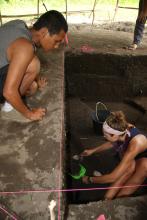Professor Peter Lape has been busy these past few years. In 2006, he was awarded a prestigious five-year grant from the Henry Luce Foundation to build capacity for archaeological research and training in Southeast Asia through collaborative activities involving the UW and Southeast Asia archaeology institutions. So far this has resulted in a range of events, activities and further accomplishments. The grant funded a new tenure-track faculty position in the UW archaeology program (filled by Dr. Ben Marwick in 2008). It generated seven graduate fellowships in archaeology, museology and law, as well as a new course in cultural heritage law jointly administered by the Department of Anthropology, the Museology Program, and the School of Law. A speaker series was organized through which three senior scholars in archaeology from Indonesia, the Philippines, and Thailand were invited to spend a week at the UW to give talks and offer student workshops. The grant is also funding a major library digitization project, which involves cooperative agreements with universities and government agencies throughout Southeast Asia. It will generate a digital record of unpublished archaeological site reports and other key literature, which will be distributed through the UW Library system.
More recently, the Luce grant funded a series of archaeological field schools throughout different countries in SE Asia. The first course, co-taught by Dr. Lape and Dr. Daud Tanudirjo (Gadjah Mada University), took place in the Banda Islands of Indonesia in 2009 (http://courses.washington.edu/bandafs/). The field school included twenty graduate and undergraduate students from the UW and four SE Asian countries. This diverse group of students learned how to do all aspects of field archaeology, working at sites ranging from early farming villages (3,500 years ago) to spice-trading settlements occupied by the earliest Indonesian converts to Islam (800 years ago). They worked under challenging conditions handling tropical downpours and bugs, boat trips to small remote islands, and working with isolated communities that had little previous knowledge about archaeology – many residents thought the crew was searching for buried gold before students organized outreach activities like site tours, public lectures, and even a radio show! Students emerged from this experience with a new set of life-long friends, increased confidence in their field skills, and an understanding of archaeology’s relevance to local and international audiences. Many of their experiences and thoughts were expressed in a blog (http://banda-archaeology.blogspot.com/).
In March 2010, Dr. Lape will launch a second field school. It will be co-taught with Dr. Victor Paz (University of the Philippines) and will take place on Palawan Island in the Philippines, with 25 students from the UW and five SE Asian countries (http://faculty.washington.edu/plape/palawan/). Dr. Marwick and a host country counterpart in Laos or Thailand will direct the final field school of the series in 2011. For more details on this project seehttp://faculty.washington.edu/plape/Luce.htm.
Photo Caption:
Group photo at the end of BN1 excavation, Banda Neira. Starting at the back left: Professor Daud Tanudirjo (UGM), Sanpiseth Kim (Royal University of Fine Arts, Cambodia), Watana Moonkham (Silpakorn University), Emily Peterson (UW), Pak Hasan (Landowner), Alex Urmeneta (UW), Emily Jenkins (UW), Narto, Minda Polser (University of Maryland), Sarah O'Loughlin (SUNY Cortland), Dian Rahayu Ekowati (UGM), Michelle Stitzer (UW), Sofian, Soleman, Pauline Basilia (University of the Philippines), Hari Wibowo (UGM), Andy Lawless (Filmmaker), Ari Mukti Wardoyo Adi (UGM), Professor Peter Lape (UW), Josh Diles (UW), Pak LaGate (Lautaka RT)
